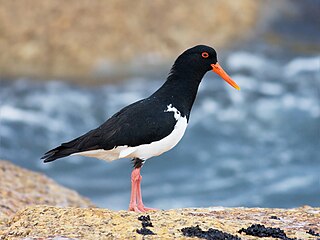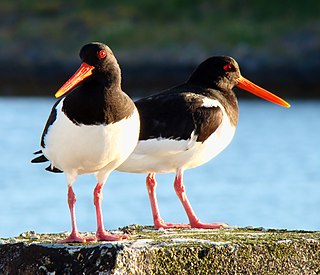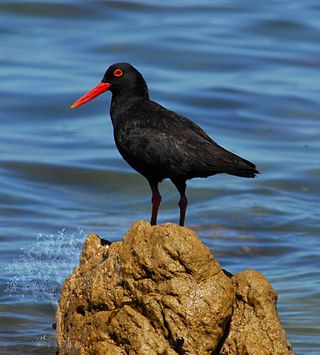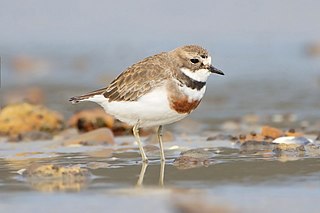
The oystercatchers are a group of waders forming the family Haematopodidae, which has a single genus, Haematopus. They are found on coasts worldwide apart from the polar regions and some tropical regions of Africa and South East Asia. The exceptions to this are the Eurasian oystercatcher, the South Island oystercatcher, and the Magellanic oystercatcher, which also breed inland, far inland in some cases. In the past there has been a great deal of confusion as to the species limits, with discrete populations of all black oystercatchers being afforded specific status but pied oystercatchers being considered one single species.

The Eurasian oystercatcher also known as the common pied oystercatcher, or just oystercatcher, is a wader in the oystercatcher bird family Haematopodidae. It has striking black and white plumage, a long straight orange-red bill, red eyes and relatively short dull pink legs. The sexes are similar in appearance but the bill of the female is longer than that of the male.

The Australian pied cormorant, also known as the pied cormorant, pied shag, or great pied cormorant, is a medium-sized member of the cormorant family. It is found around the coasts of Australasia. In New Zealand, it is usually known either as the pied shag or by its Māori name of kāruhiruhi. Older sources may refer to it as the "yellow-faced cormorant".

The spotted shag or pārekareka is a species of cormorant endemic to New Zealand. Though originally classified as Phalacrocorax punctatus, it is sufficiently different in appearance from typical members of that genus that for a time it was placed in a separate genus, Stictocarbo, along with a similar species, the Pitt shag. Subsequent genetic studies show that the spotted shag's lineage is nested within the typical shags.

The New Zealand grebe, also known as the New Zealand dabchick or weweia, is a member of the grebe family endemic to New Zealand.

The African oystercatcher or African black oystercatcher is a large charismatic wader resident to the mainland coasts and offshore islands of southern Africa. This near-threatened oystercatcher has a population of over 6,000 adults, which breed between November and April. The scientific name moquini commemorates the French naturalist Alfred Moquin-Tandon who discovered and named this species before Bonaparte.

The black oystercatcher is a conspicuous black bird found on the shoreline of western North America, ranging from the Aleutian Islands of Alaska to the coast of the Baja California peninsula.

The American oystercatcher, occasionally called the American pied oystercatcher, or PiruPiru, is a member of family Haematopodidae. Originally called the "sea pie", it was renamed in 1731 when naturalist Mark Catesby observed the bird eating oysters. The current population of American oystercatchers is estimated to be 43,000. There are estimated to be 1,500 breeding pairs along the Atlantic and Gulf Coasts of the US. The bird is marked by its black and white body and a long, thick orange beak.

The white-fronted tern, also known as tara, sea swallow, black-billed tern, kahawai bird, southern tern, or swallow tail, was first described by Johann Friedrich Gmelin in 1789. A medium-sized tern with an all-white body including underwing and forked tail, with grey hues on the over the upper side of the wing. In breeding adults a striking black cap covers the head from forehead to nape, leaving a small white strip above the black bill.

The pied oystercatcher is a species of oystercatcher. It is a wading bird native to Australia and commonly found on its coastline. The similar South Island pied oystercatcher occurs in New Zealand.

The black stilt or kakī (Māori) is a wading bird found in New Zealand. It is one of the world's rarest birds, with 169 adults surviving in the wild as of May 2020. Adult kakī have distinctive black plumage, long pink legs, and a long thin black bill. Black stilts largely breed in the Mackenzie Basin in the South Island, and are threatened by introduced feral cats, ferrets, and hedgehogs as well as habitat degradation from hydroelectric dams, agriculture, and invasive weeds.

The Chatham oystercatcher or Chatham Island oystercatcher is a species of oystercatcher. It is a wading bird endemic to the Chatham Islands, New Zealand. This species is rated by the IUCN as endangered, and has a current population of 310 to 325 birds. The main threat is from introduced predators.

The double-banded plover, known as the banded dotterel or pohowera in New Zealand, is a species of bird in the plover family. Two subspecies are recognised: the nominate Charadrius bicinctus bicinctus, which breeds throughout New Zealand, including the Chatham Islands, and Charadrius bicinctus exilis, which breeds in New Zealand's subantarctic Auckland Islands.
Hybridisation in shorebirds has been proven on only a small number of occasions; however, many individual shorebirds have been recorded by birdwatchers worldwide that do not fit the characters of known species. Many of these have been suspected of being hybrids. In several cases, shorebird hybrids have been described as new species before their hybrid origin was discovered. Compared to other groups of birds, only a few species of shorebirds are known or suspected to hybridise, but nonetheless, these hybrids occur quite frequently in some cases.

The Canary Islands oystercatcher, Canarian oystercatcher, or Canarian black oystercatcher , was a shorebird of uncertain taxonomy endemic to Fuerteventura, Lanzarote, and their offshore islets in the Canary Islands in Spain. It is now considered to be extinct.

The South Island oystercatcher or South Island pied oystercatcher is one of two common oystercatcher species found in New Zealand. Its name is often contracted to the acronym "SIPO". The indigenous Māori name is tōrea. The scientific name commemorates the German ethnographer, naturalist and colonial explorer Friedrich Hermann Otto Finsch.

The violet cuckoo is a species of cuckoo in the family Cuculidae.

The Magellanic oystercatcher is a species of wader in the family Haematopodidae. It is found in Argentina, Chile and the Falkland Islands in freshwater lake and sandy shore habitats.

The Chatham gerygone or Chatham Island warbler is a species of bird in the family Acanthizidae. It is endemic to the Chatham Islands. The Chatham Island warbler is larger than and differs in plumage from the related grey warbler of mainland New Zealand. Both warblers were discovered and named by G. R. Gray in 1845. The grey and Chatham Island warblers are the only two members of the Australasian family Acanthizidae found in New Zealand.






















